|
A couple of days ago, I was heading back from my home visit in Minnesota. The fields were beautiful and green.
It was a nice afternoon for a drive, as we passed farms and small towns along the interstate. Going past these agricultural areas reminded me of a verse of scripture which was appropriate for me at this time: “No one who sets a hand to the plow and looks to what was left behind is fit for the kingdom of God” (Luke 9:62). This time of heading back, of leaving my childhood home and loved ones, was an opportunity for me. It led me to renew my response to our Lord’s invitation to follow Him in the Consecrated Life, to leave behind what I held dear. As we passed the verdant fields of growing crops, this scripture passage reminded me to look ahead and follow Jesus rather than dwelling on what is left behind. These reflections came after several days with my mom and family in the Twin Cities. A couple of days before, one of our Sisters had brought a visitor from Germany to the Cities so she could see and experience the area before they gave me a ride back to Hankinson. She had commented on what a wonderful area it was and how vibrant the Church is there; she mentioned what a sacrifice it had been for me to leave the Archdiocese. I did not say much in response, but I sensed the truth in these words. As I reflect on this further, now, I think about how much our Sisters from Germany gave up in coming to America…how countless others made similar or greater sacrifices than mine. I realize that each of us makes sacrifices in our life of discipleship. Personally, I really appreciate the daily opportunity to bring such sacrifices and struggles, as well as joys and hopes, to the Mass as I join my Sisters in prayer. Another wonderful part of living in the convent is having Jesus present in our own home. The consoling realization that He is just down the hall can bring joy to even the dreariest of days, when the grass doesn’t look so green and the sun isn’t shining so brightly. I hope that the beautiful fields and flowers and summertime bring us all to lift our hearts in gratitude as we set our hands to the plow…and…our eyes on our Lord.
0 Comments
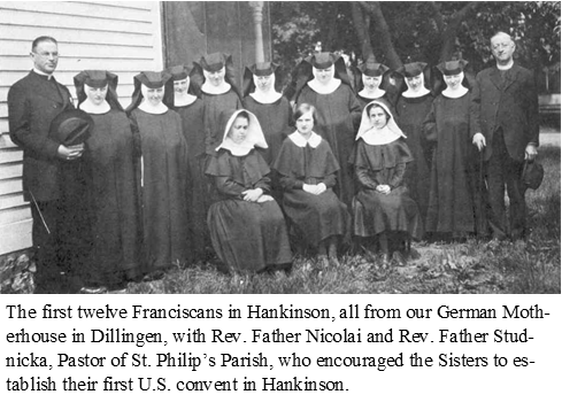 Sr. Sara Marie wrote the following reflection for our diocesan magazine. I'd like to share it. December 10th was the 95th Anniversary of our Sisters moving into St. Francis Convent, Hankinson. The group of twelve didn’t even have steps up to the front door yet, approaching over wooden planks to the landing, then up 8 or 9 more steps to the main level. I’ve been feeling nostalgic about them for over a week as I had the privilege of knowing several of them who lived to old age. Sister Mary Joseph (front left seated) was the youngest and only a teenaged postulant when she volunteered for the then historic mission to America. A few weeks after the Sisters moved in, on January 10, 1929, the first American vocation for our congregation arrived at the front door, by wagon from Mooreton. Clara would become Sister Angeline Althoff and one of the first teachers. How those first Sisters all sacrificed and worked to build up this province for the Lord and his people. Some began the Vestment Department, others taught, some served as cooks and housekeepers—all of them prayed...all of them weeded...all of them, for the glory of God, did more than their share. Sister Mary Joseph became a teacher and was warmly remembered by the alumni for standing at the door and commanding every student to wipe the mud and gravel from their shoes before walking on the floors the housekeeping Sisters had worked so hard to make shine. Sister Jean Louise always called her the memory of our Province, and that she was. We were blessed that she lived long and was mentally strong to the end. In her retirement years, she dreamt of the day we would be teaching again in our building and would walk the halls with her rosary, praying for the alumni. As it has developed, we now see our young Sisters “teaching” in our former school rooms, offering adult retreats and youth programs. Sister Mary Ruth and Sister Christina, powered by prayer, are as generous and hard working as our pioneers ever were. Sister Susan Marie heads our retreat center which now hosts several hundred people a year for private and group retreats led by other organizers. Since 1928, women have entered the consecrated life here at Hankinson, trusting God for the whole of their lives. Not all persevered, but all tried, and for that they deserve credit. Father Thomas Nelson, O.Praem., well known among Religious in this country, believes that every young Catholic should be encouraged to, or at least not impeded in any way from, exploring a call to religious life or priesthood, opening themselves to God’s will. If their call is not to a vowed consecrated life, the experience will only make them better Catholics and better people... The Church needs every vocation, and it is generous parents who God and the Church depend on to give us Priests, Sisters and Brothers. We would have nothing without our Priests, but consecrated Sisters and Brothers bring something different to the Church because of their vowed state. It is a mystery, but the fruits born by religious men and women through the centuries are plentiful, even if hidden. Now we live in a different time than 1928: small families, largely uncontrolled materialism, confusing messages from some in leadership now and then, increased media control of information, world chaos, .... Pray for young men and women to be able to generously discern God’s call as our early Sisters did, and that He will call more for the Diocese of Fargo. The good news is that, recently, we have seen young communities “dipping their toes” into North Dakota. Let us pray they will persevere here for the Church and put down deep roots like our pioneer Sisters did — flourish the way they did a hundred years ago — so greater numbers of Religious may again help in the parishes. And, pray for young women to respond to God’s call here in Hankinson. Each community has its own unique charism and we hope to see ours go on for another 95 years, along with the new ones! To paraphrase Father Nelson again: The Church belongs to God. He has a right to call individuals out of the general laity to serve in these vocations. God is calling young people to serve in Church vocations. How can we help them discern? Teach them to love the Church and Jesus in the Eucharist. In this year of Eucharistic revival, there are many ways to do that.  As I neared the end of our annual six-day silent retreat, I started getting a bit restless. During these days of quiet reflection, words from our constitutions resonated in my mind. Although not speaking specifically of retreats, I think the passage’s application here was appropriate: “General penitential times of the Church and days of recollection should awaken in us a wholesome unrest.” (Constitutions, 3:7) I couldn’t help but wonder: What in the world is wholesome unrest? I could understand the unrest part. Over 140 hours of silence (except for common prayer, table reading, and instrumental music at dinner), coupled with lack of one’s usual work routine, can make those of us with extrovert inclinations a bit stir crazy. Why, I wondered, is such a feeling considered “wholesome” by the writers of our constitutions? Usually, we don’t think of things that disrupt our peace of soul in a positive light. Wouldn’t unrest seem to fall into the category of “desolation,” which spiritual masters advise us to be cautious of? There must be something to it, though, some benefit derived from this restlessness of spirit which we consciously inflict on ourselves each year. In his closing conference, our retreat master compared annual retreats to stretching in the morning, as his cat routinely does. Perhaps, then, wholesome unrest stretches our spiritual muscles for better functioning throughout the year. 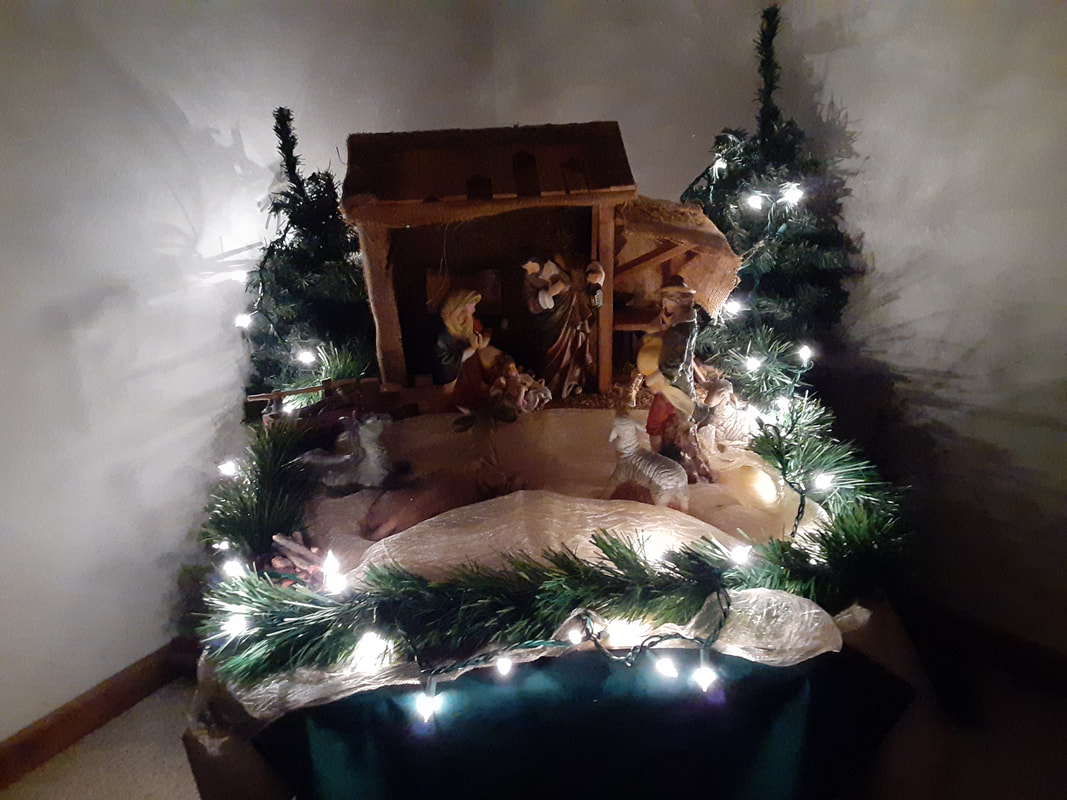 Earlier this week, after my shift at the front desk and attending weekly care conferences, I went home for a much awaited job: setting up the nativity scene in our convent chapel. Ever since my childhood, I’ve been drawn to the crèche! Back home, as we grew up, we had a special stable; my dad had made our wooden stable, and my mom had painted the ceramic figures. We had real straw from our friends’ farm. There are photos of me, sitting admiringly in front of the stable in our living room. One time, if I remember correctly, my mom didn’t know where I was, and she found me there, quietly looking at the scene. As we decorated, we would reenact the story of the first Christmas, putting the figures in place. I don’t get to help with all the decorating around here, and in the past, have missed not being able to put up the nativity set some years. I was glad to be able to do it again this year. Thinking about it now, this life-long love for the manger scene fits in very well with my life, as I am part of a Franciscan community. It was St. Francis, after all, who first (as far as we know) had the Christmas story reenacted at Greccio. As our constitutions say, “was captured by the love of Christ in the crib, on the cross, and in the Eucharist.” I pray that St. Francis may intercede for us, and our world now, that we may grow closer to Christ each day, and become more and more like Him. As promised, today I am returning to the questions I found in a little notebook from when I was on my journey toward religious life.
How many sisters are in the community? How many convents do you have? Three of us live and work here at St. Anne’s. In our North Dakota province, there are about 15 sisters. World-wide, there are several hundred Franciscan Sisters of Dillingen, in Germany, Spain, Brazil, India and the US. We currently have three convents in North Dakota. There used to be many more. Does your prayer style vary between locations? We all have the same prayer commitments (liturgy of the hours, meditation, etc.); some are in common and some private. The time of common prayers can vary from one convent to another. Sometimes, a particular local community has certain prayer customs that are not universal to our whole province. For example, at St. Anne’s here, we pray a prayer to St. Anne’s in the evening before vespers. Our other Sisters do not have this custom. In Hankinson in the summer, the Sisters often pray the blessing of the crops since they live in a more rural setting. We do not have this custom in my local community. Do you have a say in where you go? A Sister is welcome to share her thoughts on this, but it is ultimately the decision of the superior. Do you have involvement with a parish or outside? I attend Mass at the local parish on occasion. With the COVID restrictions, I was less active for a time. I am hoping to find opportunities for more involvement in the parish in the near future. I am very much involved in our Grand Forks Area Catholic Women’s group, which meets on the first Saturday of each month. I really enjoy it and appreciate the chance for faith and fellowship with the other ladies in the group. What does the vow of obedience mean? What decisions are you able to make yourself and what do you need permission to do? That question is a little bit complicated to answer. We are supposed to “discuss our plans with our superiors.” We don’t ask our superior which blouse or jumper to wear in the morning, but if we’re going out somewhere, it’s good to talk it over/get permission from our superior, especially if we’ll be missing prayer or a meal or doing something out of the ordinary. What are the challenges and rewards of this life for you? One challenge is in the fact that we’re all different. We have different ways of doing things, we grew up in different environments; we sometimes see things differently. We have to live with the fact that we’re all different…and that’s okay. I have to accept my fellow Sisters’ differences as they accept mine. On the other hand, there are many rewards to our life as well. It is wonderful to live and work under the same roof as Jesus in our tabernacles! Our life makes a rhythm of prayer easily accessible. We also, ideally, have support from our fellow Sisters in living this life. We are working together for the same mission. There is something beautiful in that.  The other evening, I got the chance to visit with a Sister from a different community. She shared about prayers they say while dressing. This reminded me of our own directives which encourage us to do this, and gave me a little nudge to try and be better at this practice. I do try to do this now, but definitely have room for improvement. I decided to reach out and ask one of our own older Sisters if she remembered what prayers they used to say as they dressed. Although she didn’t remember the exact prayers anymore, she did share her inspiring routine: I do pray my own original ones as they come. One goes like this: “O Lord, please clothe me with humility, gentleness, meekness, and kindness, Teach me the true spirit of poverty, chastity and obedience. Imbue me with the spirit of St. Francis and grant me the gifts and fruits of the Holy Spirit.” [Then I pray] for whatever comes to mind. I also pray for people who have died, especially family members, relatives, friends, and fellow Sisters. I pray for people by name…If time permits, I also pray to special saints for their intercession, and for living family and friends, especially those who need the graces to return to the Church and the Sacraments, and on and on, depending how much time I have. A person can pray for many intentions in a short time; just try it. Of course, I call on Mary to help to me to love Jesus more, and to do all for Him during the day. This afternoon, a friend of our Sisters stopped over; she was fitting me for a new jumper. Hopefully, by the time it’s ready, I’ll be into a good routine of using my time while dressing to orient myself and my day toward God, as well as intercede for the needs of the world. 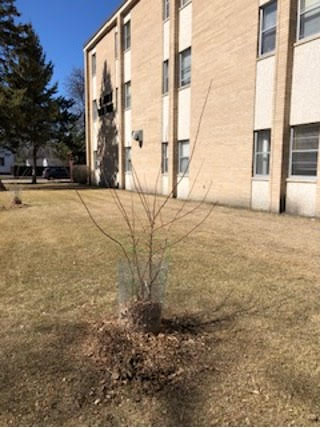 With trepidation, I started preparing in earnest for my vocation talk I have to give at the SEARCH weekend in Valley City, ND. I'd much rather write something than speak in public. Having drafted it, I decided that it would work for my blog post this week as well. When I sat down to think and pray more about this talk, my four little plum trees came to mind for some reason. I’m kind of proud of my little trees, and have to be careful that I don’t get too attached to them. As I thought more about them, I realized that there are several parallels between their development and my own vocation. About three and a half years ago, we visited the niece of one of our Sisters, who lived kind of out in the country. Among other things, she gave us some plums. I pitted them with some of the residents here, and made plum jam. Rather than throwing out the pits, I saved several of them, washed them up, and stuck them in our raised garden beds over the winter. (I learned that plum pits need a cold period in order to germinate.) At baptism, we are given the seed of faith. We have to decide what to do with it. Are we going to throw it out or preserve and nurture it? We’re also each given a vocation in life, a way that God is calling us to follow Christ and become saints. The question becomes: Do I recognize it? Do I take time to foster the growth of my faith and my vocation? For me, my vocational journey really was a process. I wasn’t born knowing I was going to be a Franciscan Sister in North Dakota. In fact, I used to make a little bit of fun of North Dakota, where my mom’s family was from. Boy, that came back to bite me!! Like my little trees, my vocational discernment took time to grow. It was the summer of my freshman year of college when being a Sister came to me at adoration at our parish, but it wasn’t until four years later that I finally found where that vocation would be lived out. During that time, I had my own struggles of various kinds; I had to go through my own “winter” before the seed of my vocation would germinate. One thing that was hard for me was not knowing where I should go. As I thought and prayed about my future, I learned more about what I would like to see in a religious community (e.g., religious garb, devotion to the Blessed Sacrament, variety of apostolates, strong community life). I visited different communities. It was a challenging time in its own way. OK…Back to my plum trees! When spring came that year, the pits had sprouted. I put them in little pots and nursed them over the summer. In the fall, I had four healthy seedlings. Others hadn’t done so well or had been given away, etc. Before I get too far ahead of myself, I want to stress that a relationship with Jesus is so important in our vocation! How are we going to know (or care about) what He wants us to do if we’re not spending time with Him and working on that relationship? Yet, we’re not on this journey alone. Our maintenance man has helped me with my little trees, digging holes, and we got the four seedlings planted in the ground. He surrounded them with leaves and netting to protect them over the winter. He continues to fertilize them. When I was exploring my vocation and trying to figure out where God wanted me, I had help from others. My mom was praying for me. I had sworn her to secrecy, but she was having trouble keeping quiet about it. I also had help from our pastor. I met with him a couple of times. After one of these visits, he offered to walk me out, asking where I was parked. I told him, having fun, “In between the two sets of doors.” I had biked to Church to meet with him. I have a vision impairment and am not able to drive a car. This fact has definitely made life more of an adventure for me! In a sense, one might say that this challenge, among others, has been a form of pruning in my life. As for my trees, last month, a volunteer and I went out and pruned the little guys (now about five feet tall). This is so they would focus energy on growing up rather than getting bushy. We also eliminated competitor branches and those which were growing toward the trunk as this would cause problems down the road. In the course of their growth, the plums went from the gardens to pots to the outdoors. Also, in my life, God let me be in different places for a time; all of these taught me something. One example from my days of exploring was when I visited a community in Connecticut. The community there had a lot of silence. I realize that there is definite spiritual benefit in times of silence, but the experience also taught me that a lot of silence was not such a great fit for me, personally. During my time of trying to find “the right place,” I ended up in Chicago, through Amish country in Wisconsin on the bus (the guys who boarded the bus at one point smelled like they’d just gotten done with chores.) Soon after arriving, I realized that this community I was visiting was not right for me. I ended up contacting other convents there to see if there was another place to visit rather than wasting these Sisters’ time (and my own). I ended up spending a couple of days with some Franciscan Sisters, who “happened to be having a ‘Come & See’ at the time. Before that, I hadn’t been open to the possibility of a Franciscan community. Although I didn’t feel called to pursue that particular one, it re-opened my to the possibility of the Franciscan order. Soon after that, I found the Franciscan Sisters in Hankinson, North Dakota. Life is certainly a journey! During this time, I had in the back of my mind, “This is what I’m supposed to do, so I’ll do it.” My parents, especially my dad, had instilled in me this readiness to do what is right and what is asked by God. For example, going to church on Sunday was not optional. However, when I was in formation in Hankinson, as I learned more about religious life, my motivation changed from duty into desire – I really wanted this life! I was learning more about the spousal dimension of consecrated life, about giving oneself to Jesus in a special way. I saw what a beautiful vocation it was! Some years later, when I made final vows, I prostrated myself on the floor of our chapel in Hankinson, as if to say, “I give myself to You; I am yours.” I made the vows of poverty, chastity, and obedience, promising to imitate my Beloved, the poor, chaste, and obedient One par excellence. The growth and journeying did not end that day, just like my tree’s development didn’t end when we stuck them in the ground a couple of years ago. Right now, they actually look pretty bare, but if you look close, you can see some green tips on some of the branches, signs of hope and life. This past year especially has been challenging, but that is not the end. I pray that my life may be united continually to Jesus and I may produce much spiritual fruit for Him, just as I am hoping that, someday, we have big trees that produce fruit. 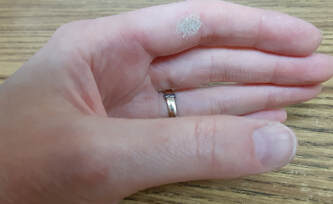 A week and a half ago, I spent some time in the afternoon (after finishing my shift at the reception desk and attending resident care conferences) cutting up some bread. We had received a large donation of day-old Panera breads of all kinds: sour dough, cinnamon-sugar glazed, and more. After advertising it to our staff (for them to help themselves) and taking some for our kitchen’s use, there was still quite a bit left. Two viable options (besides just sticking it all in the freezer) arose for me. Croutons and bread pudding could both be made out of leftover bread. I ended up making some of each, using sour dough loafs for the former and cinnamon-sugar glazed bagels for the latter. Unfortunately, though, the project left a tender blister on the forefinger of my left hand. (Yes; I am a lefty.) Finally, I noticed this morning that it has really started to heal. The now crusty area is actually shrinking a little. It sure was sore for a while, though! I think of this after hearing and reflecting upon the gospel reading this Sunday as well as a poem that was shared from a funeral of a Sister we know. The poem was about “The Hands of a Sister.” It chronicled some of the different types of work religious Sisters have traditionally done: forming and teaching little children, caring for the sick, etc. Some of the deeds described there were not ones that I am called to engage in. Nonetheless, it made me think about my hands and what they do on a daily basis. I pray they may always serve in a way pleasing to Our Lord. I think this Sunday’s gospel (about the servants entrusted with varying amounts of money) fits with this reflection, also. Like these servants, each of us will be called to give an account for how we used what was given to us, what our “hands” did with the gifts we received. I hope and pray that, like the first two servants, at the end of our lives, each of us will have a good return to show on God’s investment in us. However, as I write this, I can’t help but think about St. Therese of Lisiuex’s reflection on empty hands: “In the evening of life I shall appear before you with empty hands, for I am not asking you, Lord, to count my works.” Her humble, trusting attitude is something for us to really think about and seek to emulate. While my hands are engaged in the humble work of cutting up old bread, washing out a resident’s support socks, or taking someone’s temperature, my eyes (inspired by the Little Flower) can be fixed in trust on Jesus.  This beautiful time of year is rich in so many memories, so many wonderful times with family and friends, along with the beautiful colors of the leaves that are now starting to fall from the trees. It’s also the time for high school “Homecoming.” However, this year, I’m sure events are being curtailed or modified due to the Coronavirus. Nonetheless, this week, I had my own sort of homecoming. I was invited to come down to our provincial house in Hankinson to help with our community’s newsletter. It’s been a while since an issue came out. I had never worked on layout for this particular newsletter before (although I had written a few articles for it over the years), so it was a new experience. It was a fun challenge to undertake, though. I arrived at the convent about 1 p.m. Tuesday, and, after bringing my bags upstairs, met right away with the Sister whom I was to help with this project. After an afternoon of work, it was time to join the other Sisters in the chapel for the rosary and vespers. As I walked into the large chapel and found the pew that I have been using during recent visits, a sense of homecoming came over me. This was the place where I had begun my formation for religious life, and where I had made my vows. It was the place that I had first visited as a 24 year-old, not too long out of college. While it was not the house I grew up in, as a “Hankinson Franciscan,” it is a sort of spiritual home. I am grateful to God for bringing me here, for guiding my along my life’s path, and calling me to this amazing (if, at times, challenging) vocation. I pray and trust that He will continue to be with me on this journey; I hope, too, that one day I may have a final homecoming in heaven. 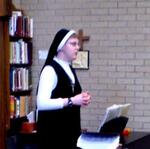 This evening, as we were praying vespers, one of the antiphons struck a chord with me, reminding me of a song I learned during my college years: “To the King of ages, immortal and invisible, be all honor and glory, alleluia.” This song (paraphrased from 1 Timothy 1), has always been powerful in lifting my heart up in praise. Since praying the antiphon this evening, now, that song has been coming back into my mind - it’s kind of catchy. (Sometimes, not being able to get a song out of your head can be a good thing, too.) I was also struck this evening at how many times the prayers referred to God’s kingship. During this time of seemingly unprecedented realities, this “age” of physical distancing, wearing masks, staying home, and rising numbers of ‘confirmed cases,’ it is good to remember that Jesus is truly the king of ALL ages. He is with us as he promised “even until the end of time.” Also, to quote another song we can remember that “He’s got the whole world in His hands.” This is good news which can inspire our hearts to break into praise even (or especially) during the “age” of COVID-19. “To the King of ages, immortal and invisible, be all honor and glory, alleluia.” This blog just moved here, but it started several years ago.
To view older posts, please visit: https://ndfranciscans.weebly.com/blog and https://ourfranciscanfiat.wordpress.com |
Archives
October 2025
|


 RSS Feed
RSS Feed